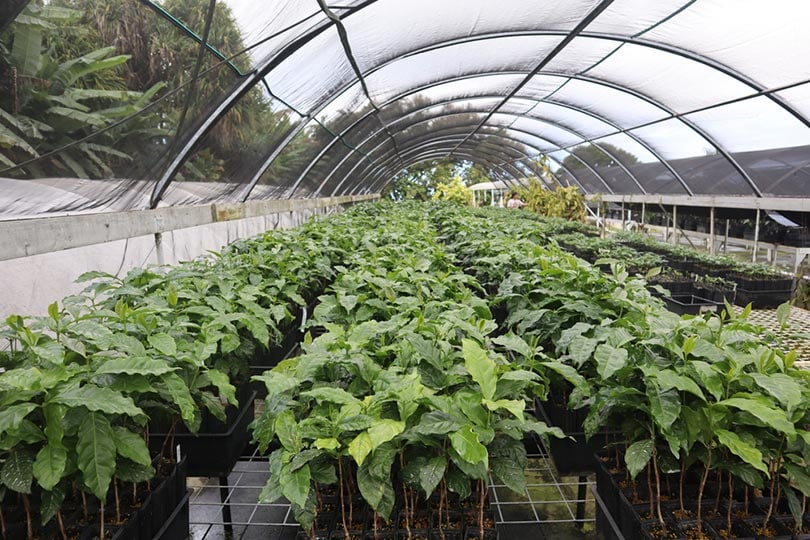As an Amazon Associate CoffeeXplore.com earns from qualifying purchases.
Greenhouse Coffee: A Start-to-Finish Grower’s Guide
Have you ever dreamed of sipping a cup of coffee brewed from beans you grew yourself? For most, the idea seems impossible, a luxury reserved for tropical climates. The challenge of replicating the delicate balance of a high-altitude coffee farm feels daunting, leaving many enthusiasts to wonder if it’s even feasible to cultivate this beloved plant in a backyard setup.
Yes, you can absolutely and successfully grow coffee in a greenhouse. This method gives you complete control over the temperature, humidity, and light, allowing you to create the perfect tropical microclimate for coffee plants to thrive, even in non-tropical regions.
Leveraging extensive analysis of horticultural data and established greenhouse practices, this guide unpacks the proven approaches and critical insights you need. We’ll walk you through everything from understanding the plant’s core needs and designing your greenhouse to managing expectations for your very first harvest. This is your start-to-finish blueprint for growing coffee at home.
Key Facts
- Climate Control is Key: The primary advantage of a greenhouse is the ability to precisely control temperature, humidity, and light, successfully replicating the tropical conditions coffee plants require to thrive, a fact supported by multiple research initiatives.
- Specific Temperature Range: Coffee plants, particularly Coffea arabica, demand a consistent temperature between 60°F and 70°F (15°C and 21°C) for optimal growth and berry production.
- Patience is a Virtue: From planting a seed or seedling, it typically takes 3 to 5 years for a coffee plant to mature and produce its first harvest of coffee cherries.
- Yields are for Hobbyists: A single, healthy greenhouse-grown coffee plant will produce a limited amount of beans, with top performance yielding only one to two pounds of roasted beans annually—enough for a few special cups, not a full supply.
- A Mini Research Station: Greenhouse coffee cultivation is not just a hobby; it’s a form of small-scale agricultural innovation. Research labs use identical controlled environments to study climate adaptation strategies for coffee farmers around the world.
Is Growing Coffee in a Greenhouse Worth It? The Definitive 2025 Guide
Yes, coffee can be successfully grown in a greenhouse. This method provides precise control over temperature, humidity, and light, making it possible to cultivate coffee plants in non-tropical climates and protect them from weather extremes. While it requires dedication and won’t yield a commercial-level harvest, the process is a rewarding journey for any coffee enthusiast. Data from projects in both the US and the Netherlands confirm that with the right setup, you can make a coffee bush bloom and eventually harvest its berries right in your own backyard.
This approach comes with a distinct set of pros and cons that are crucial to understand before you begin.
Key Advantages
* Complete Climate Control: You can perfectly replicate the cool, misty, tropical highland environment that coffee loves, regardless of the weather outside.
* Year-Round Production: A controlled environment means you’re not bound by seasons, allowing for continuous growth and flowering cycles.
* Protection from Extremes: Your plants are shielded from damaging frost, unpredictable weather, and common agricultural pests.
* Optimized Growth: By maintaining ideal conditions, you can foster healthier plants with potentially longer flowering periods, as demonstrated in research by institutions like Wageningen University & Research (WUR).
Primary Challenges
* Limited Yield: Be realistic. A small-scale greenhouse will produce a very small amount of coffee, often just enough for a few special cups per year.
* High Initial Cost: Setting up a greenhouse with automated climate control systems can be a significant investment, though passive, more cost-efficient options exist.
* Patience Required: This is not a short-term project. It takes several years for a coffee plant to mature and produce its first crop.
But is the quest for a homegrown cup of coffee right for you? Let’s find out.
Understanding Your Coffee Plant: Core Requirements for Success
Before you build a single wall, you need to understand the world your coffee plant wants to live in. Coffee plants, especially the popular Coffea arabica species, are not forgiving. They evolved in a very specific environment, and your success hinges on how well you can recreate it.

Coffee plants require a specific tropical environment: temperatures between 60-70°F, high humidity, diffused (not direct) sunlight, and loamy, well-drained soil with a neutral pH. Meeting these non-negotiable parameters is the foundation of successful greenhouse coffee cultivation.
Pro Tip: Think ‘cool tropical highlands’ or ‘misty cloud-like conditions’—that’s the environment you’re aiming to replicate for your coffee plant. This mental image, derived from studying their natural habitat, will guide every decision you make.
Here’s a breakdown of the core environmental factors:
| Environmental Factor | Ideal Condition | Why It’s Crucial |
|---|---|---|
| Temperature | 60°F – 70°F (15°C – 21°C) | This specific range encourages healthy growth and flowering. Temperatures outside this band can stress the plant and inhibit berry production. |
| Light | Diffused, Indirect Sunlight | Direct, harsh sunlight will scorch the leaves. The plant thrives in the dappled light found under the canopy of larger trees in its native environment. |
| Soil | Loamy, Well-Drained, pH ~7 | The soil must hold moisture without becoming waterlogged, which can cause root rot. A neutral pH is best, as soil that is too acidic or alkaline will kill the plant. |
| Water | Consistently Moist (not soggy) | Coffee plants need consistent moisture, equivalent to about 6 inches of water per month. The soil should never be allowed to completely dry out. |
| Humidity | High | High humidity mimics the misty, cloud-like conditions of their native habitat. This is one of the most important factors to control in a greenhouse. |

Step 1: Designing Your Coffee Greenhouse Setup
With the plant’s needs defined, you can now design a structure that meets them. Creating a successful coffee greenhouse is an exercise in environmental engineering, where your goal is to build a self-contained tropical ecosystem.
To set up a greenhouse for coffee, focus on four key areas: 1) regulating temperature between 60-77°F, 2) maintaining high humidity with misting systems, 3) using shade cloth for diffused light, and 4) ensuring moderate airflow.
Here is how to tackle each critical component:
- Install Temperature Controls: Consistent temperature is non-negotiable. For a high-tech approach, systems with SunSense™ controllers allow you to monitor and adjust the environment remotely. For a more passive or budget-friendly setup, focus on padded fans for cooling, automated vents, and good screening systems to manage heat buildup.
-
Set Up a Misting System: This is the most effective way to achieve the high humidity that coffee plants crave. High-pressure misting systems create a fine fog that mimics the misty conditions of a cloud forest, keeping the air moist without oversaturating the soil. This is far more effective than just watering the plants.
-
Manage the Light: Your coffee plant needs bright, but indirect, light. The easiest way to achieve this is with shade cloth. This fabric is designed to filter a certain percentage of sunlight, protecting the delicate leaves from getting scorched. Some greenhouse materials, like Solexx™, are specifically designed with natural light diffusion properties that are perfect for growing coffee.
-
Ensure Proper Airflow and Soil: Good airflow is necessary to keep plants cool and prevent the growth of mold in a high-humidity environment. Simple fans can achieve this. For the soil, start with a high-quality, fast-draining potting mix. You can improve its quality by adding organic matter like peat moss, composted cow manure, or bone meal to provide essential nutrients.

Quick Fact: Research labs use similar controlled environments to develop climate adaptation strategies for coffee farmers worldwide, so you’re essentially creating your own mini research station!
Step 2: From Seed to Plant – Ongoing Care
Once your greenhouse environment is stable, the long and rewarding process of cultivation begins. Growing coffee requires patience and a consistent care routine, broken down into two main phases: planting and long-term maintenance.
Plant soaked seeds in moist, well-drained soil; expect germination in 2-6 months. Care for the plant with regular watering, monthly fertilization, and pruning. The first berries typically appear after 3 to 5 years.
Be patient: this timeline is a core part of the experience. You are cultivating a tree, not a simple houseplant. Here is a breakdown of the process.
Initial Planting Steps:
- Prepare the Seed: If starting from seed, soak it in water for 24 hours. This softens the outer layer and encourages germination.
- Planting Medium: Plant the seed in a pot filled with moist vermiculite or a prepared, fast-draining soil mix.
- Germination: Keep the soil consistently moist. Germination is a slow process and can take anywhere from 2 to 6 months.
- Transplanting: Once your seedling grows to be about 24-36 inches tall, it’s ready to be moved into its final, larger pot or growing bed within the greenhouse.
Ongoing Plant Care:
- Watering: Use rainwater if possible and keep the soil consistently moist but never soggy. Check the soil daily.
- Fertilizing: Coffee plants are heavy feeders. They benefit from a weekly boost of a nitrogen-rich fertilizer or a monthly feeding with organic options like worm castings or compost.
- Pruning: Coffee plants are evergreens and can grow quite large. Prune them annually to maintain a manageable size and shape for your greenhouse space. This also encourages the plant to put its energy into producing fruit.
- Pollination: If your greenhouse is fully enclosed without access for bees or other pollinators, you may need to hand-pollinate the flowers to ensure they produce coffee cherries.
Sourcing Your Coffee: Seed vs. Seedling
One of the first hurdles you’ll face is deciding how to start your plant. While growing from seed can be a magical experience, it comes with significant challenges.
Due to shipping restrictions and freshness issues, obtaining viable coffee seeds can be difficult. Buying a young coffee plant (seedling) from a local source is often a more practical starting point.
The biggest challenge with coffee seeds is freshness. They lose their viability very quickly after being harvested from the coffee cherry. According to experienced growers, international shipping restrictions on agricultural products make it incredibly difficult to obtain fresh, ready-to-plant seeds.
Starting with a seedling, on the other hand, bypasses this entire problem. A young coffee plant purchased from a local garden store or a specialized greenhouse has already overcome the difficult germination stage. This allows you to jump directly into the ongoing care phase, saving you months of waiting and uncertainty.
Pro Tip: Starting with a seedling from a local greenhouse or garden store is often the most practical and reliable way to begin your coffee growing journey.
Managing Expectations: Challenges & Realistic Yields
Growing coffee in a greenhouse is a project born of passion, not profit. It is essential to have a clear and realistic understanding of the challenges and the likely rewards to avoid disappointment.
Be realistic: a single greenhouse coffee plant will only produce a very small amount of beans per year. Achieving the complex flavor profile of high-altitude specialty coffee is also difficult, and the process requires significant patience and investment.
If the goal isn’t commercial production, what is it? For many, it’s the unique challenge and the quest for that perfect, personally grown cup. Here are the key realities to keep in mind:
- Extremely Limited Yield: Your reward for years of effort will be a very small harvest. A mature, top-performing plant might produce one to two pounds of roasted beans per year. For most hobbyists, the reality is just enough for a few cups per year.
- Quality is a Challenge: The coveted complex, acidic, and floral notes of specialty Arabica coffee are directly linked to the stresses of growing at high altitudes. It is very difficult to replicate these specific flavor-producing conditions in a greenhouse. You can grow delicious coffee, but it may not taste like a high-end single-origin bag from Ethiopia.
- Robusta vs. Arabica: If your goal is a strong cup with great crema for espresso, the Robusta species may be a more suitable choice for a greenhouse. It’s hardier, has higher caffeine, and is naturally grown at lower elevations, making its ideal conditions easier to replicate.
- The Multi-Year Wait: Remember the 3-to-5-year timeline. This is a long-term commitment that tests your patience and dedication.
For superior control over your greenhouse environment, investing in quality monitoring tools is essential. A reliable digital thermometer and hygrometer will help you maintain the precise temperature and humidity your coffee plants need to thrive, taking the guesswork out of your cultivation journey.
FAQs About Growing Coffee in a Greenhouse
Even with a detailed plan, specific questions often come up. Here are direct answers to some of the most common queries about growing coffee in a controlled environment.
How many years will a coffee tree produce coffee for?
An Arabica coffee tree matures in three to four years and can produce fruit for about 50 years, though the yield significantly decreases after about 30 years. Your plant is a long-term companion, and with proper care, it will reward you with harvests for decades.
Is it legal to grow coffee in the US?
Yes, it is completely legal to grow coffee in the US. It is done both commercially in states like Hawaii and California, and by hobbyists in greenhouses across the country. Individuals like Justin Laird in Fort Bragg, California, are prime examples of innovators successfully growing coffee in greenhouses, proving its legality and feasibility.
Can coffee be grown hydroponically?
Yes, coffee can be grown hydroponically. This method can lead to higher quality fruit and uses less water and fertilizer compared to traditional soil farming. The key benefits of hydroponics include:
* Higher Quality: The controlled nutrient delivery in a hydroponic system provides ideal conditions, potentially resulting in high-quality fruit with exceptional flavor.
* More Efficient Resource Use: Hydroponics requires significantly less water and fertilizer, making it a more environmentally sustainable option.
How much coffee can I expect from one plant?
A single coffee plant grown in a greenhouse will produce a very limited amount, often just enough for a few cups of coffee per year. A top-performing mature plant might yield one to two pounds of roasted beans annually. This is a project for the love of the process, not for stocking your pantry.
What should you NOT grow in a greenhouse with coffee?
To avoid pests and competition, avoid growing plants like melons, squash, potatoes, sunflowers, corn, tomatoes, onions, and garlic in the same greenhouse as your coffee plants. These plants can attract pests that may harm your coffee tree or compete for the same resources, creating an unfavorable growing environment.
Final Thoughts: The Quest for the Perfect Homegrown Cup
The journey to can coffee be grown in a greenhouse is less about the destination and more about the meticulous, rewarding process. It is absolutely possible, but it is a venture that demands precision, patience, and a passion for cultivation. It transforms the simple act of drinking coffee into a deep, personal connection with the entire lifecycle of the plant.
This is not a path to self-sufficiency in coffee, but rather a way to participate in agricultural innovation on a micro-scale. You are engaging in the same climate-control challenges that researchers are tackling for the future of coffee worldwide.
Here are your final takeaways:
- Feasibility is Confirmed: With the right technology and attention to detail, you can successfully create a tropical microclimate and grow coffee anywhere.
- Setup is Everything: Your success hinges on meticulously controlling the core needs of the plant: diffused light, high humidity, and a stable temperature between 60°F and 70°F.
- Expectations are Crucial: Embrace the process as a long-term hobby. The reward is the unique experience and the handful of perfect cups you nurtured from seed to brew, not a boundless supply of beans.
Now that you have the complete blueprint, are you ready to start your own multi-year quest for that perfect cup? Share your plans or questions in the comments below
Last update on 2025-12-13 / Affiliate links / Images from Amazon Product Advertising API

